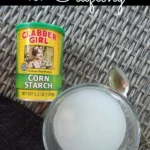How to Make Super Heavy Starch for Crafting
This post may contain affiliate links, meaning that I may earn a small commission if you make a purchase. See our disclosure policy for more information.
So you love crisp, clean shirts? Shirts that don’t move when you do? Jeans so stiff they can walk themselves to the laundry room? Sure, there’s something to be said for laundry starch, but there is also something to be said for strong starch when crafting, specifically with knitting and crochet. So here’s How to Make Super Heavy Starch for crafting at home.
How to Make Super Heavy Starch for Crafting
This super heavy homemade starch is one that I use specifically when crafting with yarn or crochet thread. I wouldn’t use this on my clothing (but you could if you watered it down significantly). In my quest for finding the perfect way to SUPER starch my newest crochet pattern (that’s a secret until later today!), I decided that store bought aerosol starch just wasn’t cutting it. It wasn’t stiff enough, I didn’t like the way it left white spots when used on dark fabric, and I wanted to be able to control the amount of stiffness of said starch.
This heavy starch uses just a two household ingredients: water and corn starch. It sounds so easy doesn’t it? That’s because it is.

Tip: The more starch you use in relation to the water, the stiffer your finished product will be.
Tip #2: Stirring together BEFORE boiling keeps it less lumpy.
Ingredients:
Water
Corn starch
Super Heavy Starch Directions:
1. Mix 1 cup cold water with 1 tbsp corn starch until clumps disappear.
Wanna save this for later?

2. Boil mixture until thick. (boiling helps to eliminate flakes or white spots when the starch dries)
3. Remove from heat and let cool.

4. Mix in about 1/2 cup cold water. (the less water added now, the stronger the starch)
5. Soak the yarn/crochet thread/fabric in the liquid.
6. Carefully squeeze extra liquid out and position item in EXACTLY the shape you wish it to dry.
If you are starching a crafted item that you want SUPER stiff, you might want to repeat this process using little to no added water at the end. Just let the boiled mixture cool to lukewarm and spoon onto the project, coating all surfaces of the yarn/fibers. Note that when I do this with large projects, I use a wide (18″) aluminum foil and lay it out on my countertop.

More homemade recipes:
How to Make Your Own Homemade Swiffer Cleaning Solution
Homemade Butter (and Buttermilk!) Using a Kitchen Mixer
How to Make Homemade Taco Seasoning
Make Homemade Dishwasher Detergent Tabs
Homemade “Cream of” Soups (Chicken, Celery, Mushroom)







